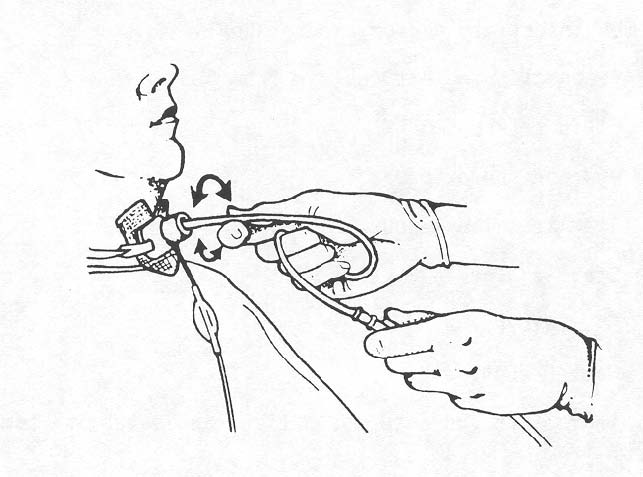2-39
2-39. PERFORMING TRACHEOSTOMY SUCTIONING
a. Assemble the necessary equipment.
(1) Portable continuous suction machine or in-wall suction.
(2) Sterile suction kit containing sterile suction catheters (14-18ºFr.), a sterile solution container, and sterile gloves.
(3) Sterile saline in a pour bottle.
(4) Sterile gauze sponges.
(5) Sterile normal saline in 5cc packets for tracheal instillation, if ordered.
(6) Oxygen source with flow meter and a manual resuscitator (ambu bag).
(7) Waste receptacle.
b. Explain the suctioning procedure to the patient if he is conscious.
(1) Hyper oxygenation will be performed. An ambu bag with 100 percent oxygen will be connected to the tracheostomy tube and the patient will be given several breaths prior to suctioning. This is done to prevent shortness of breath or hypoxia.
(2) Approximately 5cc of normal saline will be instilled into the tracheostomy tube to help liquify secretions. Inform the patient that this may stimulate a cough reflex.
c. Place the patient in semi-Fowler's position if permitted.
d. Wash your hands and set up the sterile suction kit.
(1) Open the suction kit, using the wrapper to create a sterile field. Place the sterile sponges on the field.
(2) Pour 50-100cc of sterile saline into the solution container, using a septic technique.
e. Turn on the suction unit and set to low pressure to avoid trauma to the patient.
f. Using aseptic technique, don the sterile gloves.
g. Attach the sterile suction catheter to the connecting tubing by holding the catheter in your dominant hand (sterile hand) and the connecting tube in your non-dominant hand (non-sterile hand). Refer to Figure 2-4.
h. Moisten the catheter tip in the sterile saline.
i. Instruct your assistant to hyper oxygenate the patient.
(1) Disconnect ventilator tubing if patient is receiving mechanical ventilation.
(2) Give the patient several breaths of 100 percent oxygen with the ambu bag and quickly remove the bag.
Figure 2-4. Suction catheter and connecting tube.
j. With the suction diverted, gently insert the sterile suction catheter into the tracheostomy tube until slight resistance is felt, then pull back slightly.
k. Apply suction.
(1) Place the thumb of your non-dominant (non-sterile) hand over the suction control port of the catheter.
(2) Rotate the catheter between the thumb and index finger of your sterile hand while withdrawing the catheter. Apply intermittent suction while withdrawing.
(3) Suction only for 5-10 seconds. Refer to Figure 2-5.
l. Instruct the assistant to hyper oxygenate the patient while you rinse the catheter by suctioning a small amount of the sterile saline.
m. If secretions are thick, instill 5 cc of sterile normal saline into the tracheostomy tube and suction again.
Figure 2-5. Tracheostomy suctioning.
n. Repeat the suction procedure until the airway is clear.
(1) Hyper oxygenate the patient between suctioning.
(2) Rinse the catheter between suctioning.
o. Reconnect the patient to the ventilator if one is in use.
p. Perform oropharyngeal suctioning, if required.
q. Discard used equipment and restock the patient's bedside with new equipment.
r. Record the procedure in the Nursing Notes.



